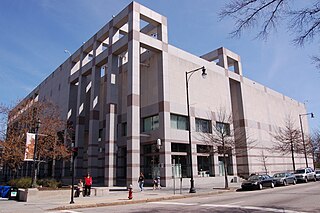
The National Archives Building, known informally as Archives I, is the headquarters of the United States National Archives and Records Administration. It is located north of the National Mall at 700 Pennsylvania Avenue, N.W. in Washington, D.C. The rotunda entrance is on Constitution Avenue, and the research entrance is on Pennsylvania Avenue. A second larger facility, Archives II, also known as A2, is located in College Park, Maryland.

The Wisconsin State Capitol, located in Madison, Wisconsin, houses both chambers of the Wisconsin Legislature along with the Wisconsin Supreme Court and the Office of the Governor. Completed in 1917, the building is the fifth to serve as the Wisconsin capitol since the first territorial legislature convened in 1836 and the third building since Wisconsin was granted statehood in 1848. The Wisconsin State Capitol is the tallest building in Madison, a distinction that has been preserved by legislation that prohibits buildings taller than the 187 feet (57 m) columns surrounding the dome. The Capitol is located at the southwestern end of the Madison Isthmus in downtown Madison, bordered by streets that make up the Capitol Square.

The Texas State Capitol is the capitol and seat of government of the U.S. state of Texas. Located in downtown Austin, Texas, the structure houses the offices and chambers of the Texas Legislature and of the Governor of Texas. Designed in 1881 by architect Elijah E. Myers, it was constructed from 1882 to 1888 under the direction of civil engineer Reuben Lindsay Walker. A $75 million underground extension was completed in 1993. The building was added to the National Register of Historic Places in 1970 and recognized as a National Historic Landmark in 1986.

The Wadsworth Atheneum is an art museum in Hartford, Connecticut. The Wadsworth is noted for its collections of European Baroque art, ancient Egyptian and Classical bronzes, French and American Impressionist paintings, Hudson River School landscapes, modernist masterpieces and contemporary works, as well as collections of early American furniture and decorative arts.

The Hirshhorn Museum and Sculpture Garden is an art museum beside the National Mall in Washington, D.C., United States. The museum was initially endowed during the 1960s with the permanent art collection of Joseph H. Hirshhorn. It was designed by architect Gordon Bunshaft and is part of the Smithsonian Institution. It was conceived as the United States' museum of contemporary and modern art and currently focuses its collection-building and exhibition-planning mainly on the post–World War II period, with particular emphasis on art made during the last 50 years.

The Minnesota State Capitol is the seat of government for the U.S. state of Minnesota, in its capital city of Saint Paul. It houses the Minnesota Senate, Minnesota House of Representatives, the office of the Attorney General and the office of the Governor. The building also includes a chamber for the Minnesota Supreme Court, although court activities usually take place in the neighboring Minnesota Judicial Center.

The Minnesota Historical Society (MNHS) is a nonprofit educational and cultural institution dedicated to preserving the history of the U.S. state of Minnesota. It was founded by the territorial legislature in 1849, almost a decade before statehood. The Society is named in the Minnesota Constitution. It is headquartered in the Minnesota History Center in downtown Saint Paul.

The New Mexico State Capitol is the seat of government of the U.S. state of New Mexico, located in its capital city of Santa Fe. It houses both chambers of the New Mexico Legislature and the offices of the Governor, Lieutenant Governor, and Secretary of State. The building is one of only eleven state capitols without a dome, and the only circular state capitol in the United States, for which it is commonly known as "the Roundhouse".

The Missouri State Capitol is the home of the Missouri General Assembly and the executive branch of government of the U.S. state of Missouri. Located in Jefferson City at 201 West Capitol Avenue, it is the third capitol to be built in the city. The domed building, designed by the New York City architectural firm of Tracy and Swartwout, was completed in 1917.

The North Dakota State Capitol is the house of government of the U.S. state of North Dakota. The capitol, a 21-story Art Deco tower, is located in Bismarck at 600 East Boulevard Avenue, and is the tallest habitable building in the state. On a 160-acre (0.6 km2) campus that also houses many other government buildings, the capitol building and the surrounding office buildings house the state's legislative and judicial branches, as well as many government agencies.

The Oregon State Capitol is the building housing the state legislature and the offices of the governor, secretary of state, and treasurer of the U.S. state of Oregon. It is located in the state capital, Salem. Constructed from 1936 to 1938 and expanded in 1977, the current building is the third to house the Oregon state government in Salem. The first two capitols in Salem were destroyed by fire, one in 1855 and the other in 1935.

The North Carolina Museum of History is a history museum located in downtown Raleigh, North Carolina. It is an affiliate through the Smithsonian Affiliations program. The museum is a part of the Division of State History Museums, Office of Archives and History, an agency of the North Carolina Department of Cultural Resources.

The Indiana Historical Society (IHS) is one of the United States' oldest and largest historical societies. It describes itself as "Indiana's Storyteller".

The Senator John Heinz History Center, an affiliate of the Smithsonian Institution, is the largest history museum in the Commonwealth of Pennsylvania, United States. Named after U.S. Senator H. John Heinz III (1938–1991) from Pennsylvania, it is located in the Strip District of Pittsburgh.

St. Paul's historic Landmark Center, completed in 1902, originally served as the United States Post Office, Courthouse, and Custom House for the state of Minnesota. It was designed by Willoughby J. Edbrooke, who served as Supervising Architect of the U.S. Treasury Department in 1891–92. Edbrooke designed a body of public architecture, much of which, like this structure, was completed after his 1896 death. Landmark Center stands at 75 West Fifth Street in Rice Park and is now an arts and culture center.

The Delaware Historical Society began in 1864 as an effort to preserve documents from the Civil War. Since then, it has expanded into a statewide historical institution with several buildings, including Old Town Hall and the Delaware History Museum, in Wilmington and the historic Read House & Gardens in New Castle.

The Minneapolis Central Library is a public library located in downtown Minneapolis, Minnesota. It is the largest library in the Hennepin County Library system. It bills itself as having "the third largest per capita public library collection of any major city in America with a collection of more than 2.4 million items—including books, DVDs, music, government documents." The 353,000-square-foot (32,800 m2) building at 300 Nicollet Mall with two levels of underground parking was designed by César Pelli and opened on May 20, 2006. It has over 300 computers for use by the public, an 8,140-square-foot (756 m2) atrium, an 18,560-square-foot (1,724 m2) green roof planted with low-growing ground cover designed to "be sun- and drought-resistant", and a host of energy-efficiency measures.

The Oklahoma Judicial Center is the headquarters of the Oklahoma Supreme Court, the Oklahoma Court of Criminal Appeals, and the Judiciary of Oklahoma. Situated near the Oklahoma State Capitol, the original structure, designed by the architectural firm Layton, Hicks & Forsyth, was built between 1929-1930 as the home of the Oklahoma Historical Society and was listed on the National Register of Historic Places as the Oklahoma Historical Society Building in 1990. The society moved to the nearby Oklahoma History Center when it opened in 2005. An annex was completed in 2011.

The Carlton County History and Heritage Center is a museum located in Cloquet, Minnesota. The building, located in former historic Shaw Memorial Library, is owned and operated by the Carlton County Historical Society. The museum is dedicated to preserving and displaying the history of Carlton County. The Society has collected and preserved the history of Carlton County since 1949 and has operated out of the building since 1987.

The Winona County History Center, located in Winona, Minnesota, is made up of two buildings, the historic Winona Armory and the modern Laird Norton Addition. The Winona County Historical Society was established in 1935, and moved into the 1915 Winona Armory in 1973 and added the Laird Norton Addition in 2010. The History Center is the Society's main museum and houses collections, exhibits, offices, and hosts programming.
























